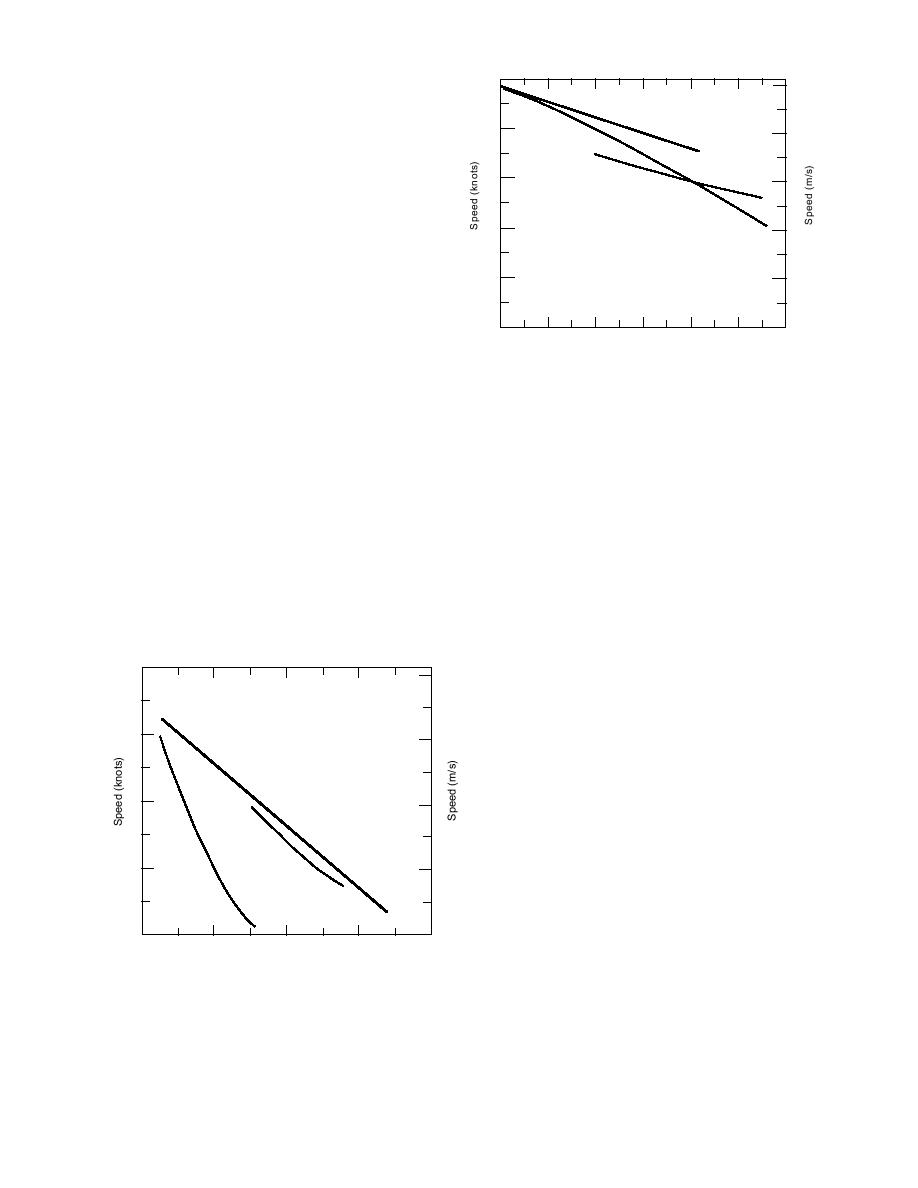
20
Icebreaker performance with
10
different hull forms
Ierusalimsky and Tsoy (1994) presented the re-
16
1
8
sults of full-scale tests conducted on three Russian
sister ships of the Kapitan Sorokin series with differ-
ent hull forms: Kapitan Sorokin, converted to a
12
2
6
Thyssen-Waas bow in 1991, Kapitan Nikolayev, con-
3
verted to a conical bow (similar to the spoon-
shaped bow) in 1990, and Kapitan Dranitsyn, still
8
4
with the original, wedge-shaped bow. The data on
the performance of these ships were obtained over
2
4
1. With Conical Bow (1990)
3 years, enabling a determination of any cost sav-
2.With Thyssen-Waas Bow (1991)
ing resulting from the conversion to bows of dif-
3. With Original Bow (1978)
ferent shapes.
0
0
For breaking a level ice sheet in forward mo-
0.4
0.8
1.2
1.6
2.0
2.4
Equivalent Ice Thickness (m)
tion, Figure 10 plots ship performance in terms of
the continuous speed of these three ships in equiv-
Figure 11. Ship speed vs. equivalent ice thickness during
alent ice thicknesses. The plots in Figure 10 show
tests in broken ice with three sister ships having different
that Kapitan Sorokin with the Thyssen-Waas bow
bow shapes. The ships were tested in their own channels (af-
has the best icebreaking capability among the three
ter Ierusalimsky and Tsoy 1994).
in level ice, closely followed by the Kapitan
Nikolayev with the conical bow. The performance
Figure 11, giving the results of the tests con-
of these two ships is much better than that of
ducted in freshly broken ice in their own channel,
Kapitan Dranitsyn with its original bow. While
shows that the performance of Kapitan Nikolayev
breaking a channel in fast ice, Kapitan Sorokin left
is better than that of the other two ships. For tests
up to 40% of the ice in the channel behind it,
conducted in broken ice in old channels, Kapitan
whereas the other ships left 8090% of the channel
Nikolayev performs better than Kapitan Dranitsyn.
filled with ice. A similar test for backward motion
In old channels full of broken ice, Kapitan Sorokin
in level ice revealed their performance in reverse
had a tendency to push broken ice ahead of itself
order as that for forward motion.
when it was not able to reach a speed of 34 knots
(1.52 m/s). Three rounded knives in the bow of
Kapitan Sorokin work efficiently to break level ice,
8
but they also obstruct the flow of broken ice un-
4
derneath the bow. At times, the buildup of an ice
1. With Original Bow (1978)
2. With Thyssen-Waas Bow (1991)
pile can bring the ship to a standstill, and force it
3. With Conical Bow (1990)
either to ram through the pile or to seek a new
6
3
path. While operating in drifting broken ice at
speeds up to 34 knots, Kapitan Sorokin showed
2
tendencies to push ice. The performance of Kapitan
4
Nokilayev improved in drifting ice fields.
2
Both ships with the Thyssen-Waas and conical
bows must reduce speeds in severe seas because
1
of considerable wave slamming in a head sea, re-
3
2
1
sulting in longer travel times.
Ierusalimsky and Tsoy (1994) have compared
the cost savings as a result of conversion of bow
shapes from conventional to the two types of un-
0
0
0.8
1.2
1.6
2.0
2.4
conventional shapes. According to them, Kapitan
Equivalent Ice Thickness (m)
Nikolayev, with the conical bow, had reduced op-
erational costs and increased profitability, whereas
Figure 10. Icebreaking capabilities of three sister ships
similar measures for Kapitan Sorokin, with the
with different bow shapes in terms of speeds in level ice of
Thyssen-Waas bow, were less favorable than those
different thicknesses at a power level of 16.2 MW (after
for the ship with the original bow. It should, how-
Ierusalimsky and Tsoy 1994).
11



 Previous Page
Previous Page
